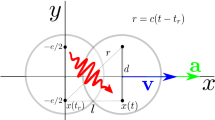We make a brief review of the Kramers escape rate theory for the probabilistic motion of a particle in a potential well U(x), and under the influence of classical fluctuation forces. The Kramers theory is extended in order to take into account the action of the thermal and zero-point random electromagnetic fields on a charged particle. The result is physically relevant because we get a non-null escape rate over the potential barrier at low temperatures (T → 0). It is found that, even if the mean energy is much smaller than the barrier height, the classical particle can escape from the potential well due to the action of the zero-point fluctuating fields. These stochastic effects can be used to give a classical interpretation to some quantum tunneling phenomena. Relevant experimental data are used to illustrate the theoretical results.
Similar content being viewed by others
References
Kramers H.A. (1940). “Brownian motion in a field of force and the diffusion model of chemical reactions”. Physica 7:284
Hänggi P., Talkner P., and Borkovec M. (1990). “Reaction-rate theory: fifty years after Kramers”. Rev. Mod. Phys. 62:251
Marshall T.W., and Santos E. (1995). “Semiclassical treatment of macroscopic quantum relaxation”. An. Fis. 91:49
Marshall T.W. (1963). “Random electrodynamics”. Proc. Royal Soc. London 276A: 475
Boyer T.H. (1975). “Random electrodynamics: the theory of classical electrodynamics with classical electromagnetic zero-point radiation”. Phys. Rev. D 11:790
França H.M.,, Franco H., and Malta C.P. (1997). “A stochastic electrodynamics interpretation of spontaneous transitions in the hydrogen atom”. Eur. J. Phys. 18:343
Cole D., and Zou Y. (2003). “Quantum mechanical ground state of hydrogen obtained from classical electrodynamics,” Phys. Lett. A 317:14
Boyer T.H. (1980). “A brief survey of stochastic electrodynamics”. In: Barut A.O. (eds). Foundations of Radiation Theory and Quantum Electrodynamics. Plenum, New York, p. 49
de la Peña L. and Cetto A.M. (1996) The Quantum Dice. An Introduction to the Stochastic Electrodynamics. Kluwer Academic, Dordrecht
Milonni P.W. (1976). “Semiclassical and quantum-electrodynamical approaches in nonrela tivistic radiation theory”. Phys. Rep. 25:1
Jackson J.D. (1975), Classical Electrodynamics, 2nd edn. Wiley, New York Chaps. 9 and 17.
Chandrasekhar S. (1943). “Stochastic problems in physics and astronomy”. Rev. Mod. Phys. 15:1
Alberding N., Austin R.H., Beeson K.W., Chan S.S., Eisenstein L., Frauenfelder H., and Nordlund T.M. (1976). “Tunneling in ligand binding to heme proteins”. Science 192:1002
Baublitz M. Jr. (1995). “Electron field-emission data, quantum mechanics, and the classical stochastic theories”. Phys. Rev. A 51:1677
Baublitz M., Jr. (1993). “Electron-tunneling spectroscopy: a test of quantum mechanics”. Phys. Rev. A 47:R2423
Plummer E.W., and Gadzuk J.W. (1970). “Surface state on tungsten”. Phys. Rev. Lett. 25:1493
Nelson E. (1966). “Derivation of the Schrödinger equation from Newtonian mechanics”. Phys. Rev. 150:1079
Merzbacher E. Quantum Mechanics (Wiley, New York, 1970). See in particular the tunneling associated with the ammonia molecule (NH3) (Sec. 5, Eq. (5.63)).
Faria A.J., França H.M., Malta C.P., and Sponchiado R.C. (2002). “Critical assessment of the Schrödinger picture of quantum mechanics”. Phys. Lett. A 305:322
Author information
Authors and Affiliations
Corresponding author
Rights and permissions
About this article
Cite this article
Faria, A.J., França, H.M. & Sponchiado, R.C. Tunneling as a Classical Escape Rate Induced by the Vacuum Zero-point Radiation. Found Phys 36, 307–320 (2006). https://doi.org/10.1007/s10701-005-9017-9
Received:
Published:
Issue Date:
DOI: https://doi.org/10.1007/s10701-005-9017-9



